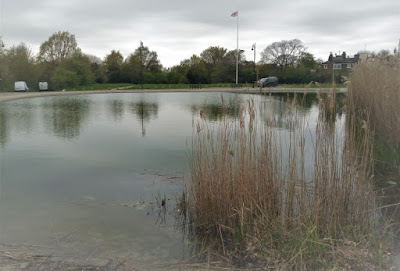I walked the entire course of the River Westbourne earlier this week and I've still got blisters. Very glad I did it though. The Westbourne is one of the Thames' lost tributaries as it's almost completely below London's streets these days, but its influence can still be seen in the landscape.
Several years ago I was given a copy of London's Lost Rivers - A Walker's Guide by Tom Bolton and meant to follow the walks within in it, but I was busy and then the pandemic happened. So, it stayed on my shelf except when I used it as a wonderful reference book when I wrote the London section for Rivers of London - The Roleplaying Game.Before starting our trek we met in the coffee shop at Waterstone's in Hampstead, surrounded by books on travel, which seemed appropriate. Ben Aaronovitch, author of the Rivers of London novels once worked as a bookseller for Waterstones. A haunted branch features in one of his short stories and Hampstead is the location for his novella What Abigail Did That Summer.
The walk in London's Lost Rivers starts at Whitestone Pond on Hampstead Heath (picture at the top of this post). It's at the highest point in London and close to the source of three London rivers: the Tyburn, the Fleet and the Westbourne. The route leads down a grassy slope to a rather muddy pond (pictured above right), which is the last you see the Westbourne above ground for most of its length. But, even though you can't see the river, you can sometimes hear it through manhole covers as the water rushes below the pavement. You can also see traces of its route in depressions in the land and in the names of streets and buildings along the way.The first part of the route goes through Hampstead, Kilburn and Paddington to Regent's Canal. That's a separate waterway as the Westbourne is channelled underneath the canal, although the walking route crosses it by bridge and leads to a park called Westbourne Green.
Helen and I next found ourselves beside water in Hyde Park. This is the most beautiful part of the walk. The Serpentine was originally created by damming the Westbourne in 1731 for Queen Caroline. However, it was basically a sewer and not very pleasant, so is now fed by other underground streams. Queen Caroline is an important background figure as a patron of magical societies in the Rivers of London books. In real life, Queen Caroline did encourage learning and apparently collected strange objects, but probably wasn't a secret magic practitioner.
The course of the Westbourne these days runs beneath the path at the edge of the Serpentine. Water from the lake flows under a bridge into water gardens. Below the gardens, both streams mix and continue on to the Thames. The outflow is near Chelsea Bridge and can be seen from the foreshore at low tide. In the Rivers of London, the goddess of the Westbourne prefers to go by the name of Chelsea. I took the photo at the bottom from Chelsea Bridge looking westward over the Thames.Helen and I did the entire journey in about 7 hours. London's Lost Rivers says it's an 8-mile walk, but for us it was nearer 9. Maybe that's because we got lost a couple of times and detoured to cafes. Although I was tired and footsore by the end of it, I enjoyed every moment. Highlights were the green spaces at Hampstead, Paddington Recreation Ground and Hyde Park, the glimpses and sounds of running water, and the atmospheric side streets and historic mews that follow the course of the lost river and are often missed by those rushing through London's main thoroughfares.
You can view London's Lost Rivers - A Walker's Guide by Tom Bolton on Amazon and find Rivers of London - The Roleplaying Game on publisher Chaosium's website. If you fancy doing something a bit different over the bank holidays, you could walk a river or try a roleplaying game about occult mysteries involving the goddesses of London's waters. (I know which one will make your feet ache more.)
(Note: I earn commission from advertisers for some links. This helps support my blog at no extra cost to those who read my posts.)
Previous related posts
http://www.badwitch.co.uk/2021/08/guided-visualisation-element-of-water.html
http://www.badwitch.co.uk/2023/04/my-novel-and-rpg-writing-with-ben.html
http://www.badwitch.co.uk/2023/04/charity-shop-find-cult-of-water-line.html
http://www.badwitch.co.uk/2021/12/sacred-sites-st-cedds-well-north.html
http://www.badwitch.co.uk/2019/09/london-gods-neptune-at-secret-rivers.html






1 comment:
That's a wonderfully evocative account and just enough to be very tempting. It makes me wonder about walking the length of some of the canalised and covered rivers near me!
Post a Comment